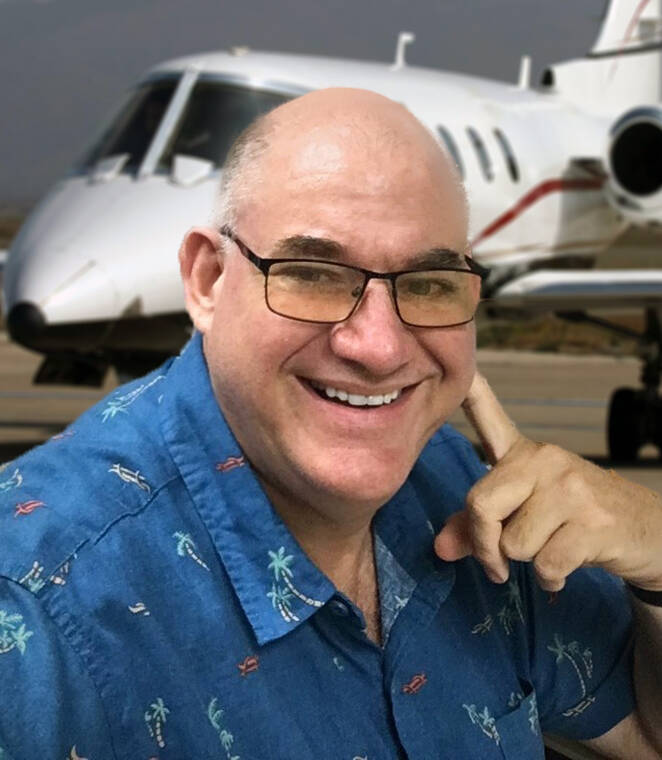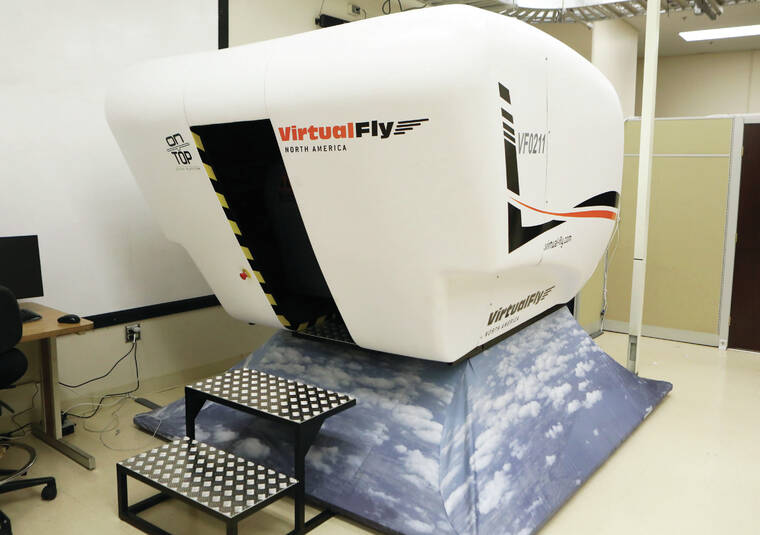Students enrolled in the University of Hawaii at Hilo’s Aeronautical Science Program are ready to take off inside new virtual flight simulators that arrived on campus this year.
The Virtual Fly On Top Duo full-motion simulators will debut this fall, providing students with an opportunity to train in various simulated weather conditions and controlled aircraft system failures without ever having to leave the ground.
Arriving from Barcelona, Spain, the two simulators will be utilized by both the Commercial Pilot Training and Commercial Aerial Information Technology concentrations within the Aeronautical Science Program.
“Safe simulation equipment allows for critical instruction on flight operational scenarios, such as various weather conditions and aircraft system failures, without placing the flight instructors or students in unsafe conditions,” said Bruce Mathews, dean for the College of Agriculture, Forestry and Natural Resources Management.
Installation was challenging for the department due to the size and advanced technology associated with the new simulators. Unable to fit through the door, the department was forced to break down the simulators and rebuild them inside the training area.
“Due to their destination … the simulators have to be uncrated and disassembled in order to make it into the simulator lab for reassembly,” said Tim Ward, Aeronautical Sciences coordinator and instructor.
Students in the Aeronautical Science Program previously trained on three single-place, nonmotion simulators, which provided an initial familiarization with aircraft systems, but was unable to run the complex training programs that can now be utilized.
“The simulators lacked a tactile functionality interface with avionics systems,” Ward said. “Which ultimately is necessary for cost-effective, valuable training for the students when transitioning into aircraft during the flight training phase.”
This helps students gain additional flight time and practice prior to attending the Airline Transport Pilot, or ATP training that takes place in Chandler, Ariz., during their senior year, when students get in-aircraft experience.
“The unique part of the UH-Hilo Aeronautical Science programs is that all the actual flying of aircraft and drones is condensed into the senior year, which reduces time dedicated to relearning activities when there are gaps in such instruction,” Ward said. “The total education costs are also lower than comparable programs.”
The UH-Hilo website lists the cost of the four-year Commercial Professional Pilot Concentration, also known as the CPPT program, at roughly $162,664.80, which includes tuition, flight instruction, books and supplies, meals and housing and other personal expenses.
The Aeronautical Science Program also has two single-place nonmotion Approved Aviation Training Devices which help students log the appropriate time to meet their Federal Aviation Administration flight time requirements for certification.
Students completing the CPPT program are eligible to earn their ATP certificate after completing 1,500 hours of flight time, 250 of which are earned during training. Students can earn additional hours while flying as a certified flight instructor, a second in command at a regional airline, working for private transportation companies, or other venues.
The UH-Hilo program first received full accreditation in July 2020, and the first cohort is expected to finish the program in spring of 2023.
Those hoping to enroll in the program and test out the new simulators are encouraged to apply during the 2023-24 school years.
“There are no admissions for 2022-23, and we won’t open new admissions until the new faculty positions just approved in the past legislative session are filled,” said Ward. “We hope to reopen admissions for ’23-’24. COVID-19 and resource challenges no doubt hurt student retention in the first cohort.”
The Legislature earlier this year approved $190,000 to help fund the program.
In addition to the new simulators, the program is looking to expand and improve other technology in order to assist with the training portion of the CPPT concentration.
“A priority next step for the program will be to obtain requisite support to purchase more advanced drones and particularly requisite sensors and onboard robotics,” Mathews said. “There is also a critical need to improve interdisciplinary links among faculty disciplines for data modeling and interpretation to make the information obtained using drones more practical for local small farmers and natural resource manager use.”
Email Grant Phillips at gphillips@hawaiitribune-herald.com.









